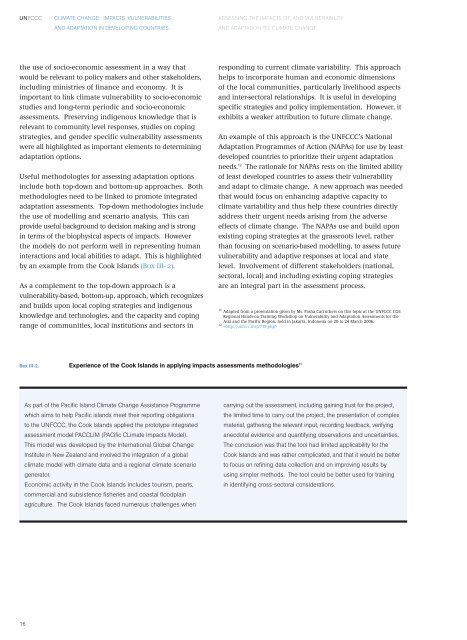impacts
Create successful ePaper yourself
Turn your PDF publications into a flip-book with our unique Google optimized e-Paper software.
UNFCCC<br />
CLIMATE CHANGE: IMPACTS, VULNERABILITIES<br />
AND ADAPTATION IN DEVELOPING COUNTRIES<br />
ASSESSING THE IMPACTS OF, AND VULNERABILITY<br />
AND ADAPTATION TO, CLIMATE CHANGE<br />
the use of socio-economic assessment in a way that<br />
would be relevant to policy makers and other stakeholders,<br />
including ministries of finance and economy. It is<br />
important to link climate vulnerability to socio-economic<br />
studies and long-term periodic and socio-economic<br />
assessments. Preserving indigenous knowledge that is<br />
relevant to community level responses, studies on coping<br />
strategies, and gender specific vulnerability assessments<br />
were all highlighted as important elements to determining<br />
adaptation options.<br />
Useful methodologies for assessing adaptation options<br />
include both top-down and bottom-up approaches. Both<br />
methodologies need to be linked to promote integrated<br />
adaptation assessments. Top-down methodologies include<br />
the use of modelling and scenario analysis. This can<br />
provide useful background to decision making and is strong<br />
in terms of the biophysical aspects of <strong>impacts</strong>. However<br />
the models do not perform well in representing human<br />
interactions and local abilities to adapt. This is highlighted<br />
by an example from the Cook Islands (Box III- 2).<br />
As a complement to the top-down approach is a<br />
vulnerability-based, bottom-up, approach, which recognizes<br />
and builds upon local coping strategies and indigenous<br />
knowledge and technologies, and the capacity and coping<br />
range of communities, local institutions and sectors in<br />
responding to current climate variability. This approach<br />
helps to incorporate human and economic dimensions<br />
of the local communities, particularly livelihood aspects<br />
and inter-sectoral relationships. It is useful in developing<br />
specific strategies and policy implementation. However, it<br />
exhibits a weaker attribution to future climate change.<br />
An example of this approach is the UNFCCC’s National<br />
Adaptation Programmes of Action (NAPAs) for use by least<br />
developed countries to prioritize their urgent adaptation<br />
needs. 12 The rationale for NAPAs rests on the limited ability<br />
of least developed countries to assess their vulnerability<br />
and adapt to climate change. A new approach was needed<br />
that would focus on enhancing adaptive capacity to<br />
climate variability and thus help these countries directly<br />
address their urgent needs arising from the adverse<br />
effects of climate change. The NAPAs use and build upon<br />
existing coping strategies at the grassroots level, rather<br />
than focusing on scenario-based modelling, to assess future<br />
vulnerability and adaptive responses at local and state<br />
level. Involvement of different stakeholders (national,<br />
sectoral, local) and including existing coping strategies<br />
are an integral part in the assessment process.<br />
11 Adapted from a presentation given by Ms. Pasha Carruthers on this topic at the UNFCCC CGE<br />
Regional Hands-on Training Workshop on Vulnerability and Adaptation Assessments for the<br />
Asia and the Pacific Region, held in Jakarta, Indonesia on 20 to 24 March 2006.<br />
12 <br />
Box III-2. Experience of the Cook Islands in applying <strong>impacts</strong> assessments methodologies 11<br />
As part of the Pacific Island Climate Change Assistance Programme<br />
which aims to help Pacific islands meet their reporting obligations<br />
to the UNFCCC, the Cook Islands applied the prototype integrated<br />
assessment model PACCLIM (PACific CLimate Impacts Model).<br />
This model was developed by the International Global Change<br />
Institute in New Zealand and involved the integration of a global<br />
climate model with climate data and a regional climate scenario<br />
generator.<br />
Economic activity in the Cook Islands includes tourism, pearls,<br />
commercial and subsistence fisheries and coastal floodplain<br />
agriculture. The Cook Islands faced numerous challenges when<br />
carrying out the assessment, including gaining trust for the project,<br />
the limited time to carry out the project, the presentation of complex<br />
material, gathering the relevant input, recording feedback, verifying<br />
anecdotal evidence and quantifying observations and uncertainties.<br />
The conclusion was that the tool had limited applicability for the<br />
Cook Islands and was rather complicated, and that it would be better<br />
to focus on refining data collection and on improving results by<br />
using simpler methods. The tool could be better used for training<br />
in identifying cross-sectoral considerations.<br />
16


